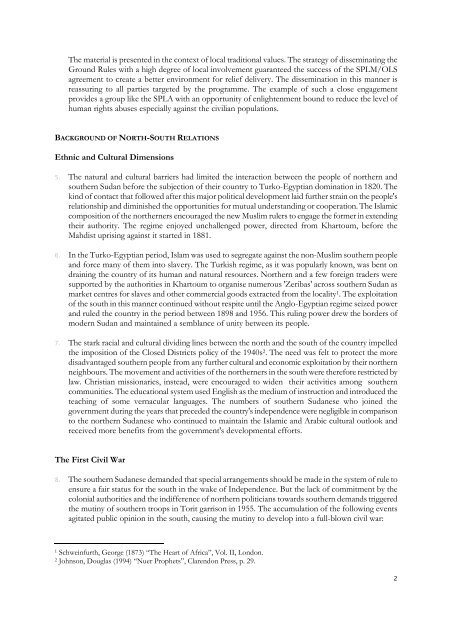105 - Sudan - Approaches to Armed Groups Kuol ... - The ICHRP
105 - Sudan - Approaches to Armed Groups Kuol ... - The ICHRP
105 - Sudan - Approaches to Armed Groups Kuol ... - The ICHRP
Create successful ePaper yourself
Turn your PDF publications into a flip-book with our unique Google optimized e-Paper software.
<strong>The</strong> material is presented in the context of local traditional values. <strong>The</strong> strategy of disseminating the<br />
Ground Rules with a high degree of local involvement guaranteed the success of the SPLM/OLS<br />
agreement <strong>to</strong> create a better environment for relief delivery. <strong>The</strong> dissemination in this manner is<br />
reassuring <strong>to</strong> all parties targeted by the programme. <strong>The</strong> example of such a close engagement<br />
provides a group like the SPLA with an opportunity of enlightenment bound <strong>to</strong> reduce the level of<br />
human rights abuses especially against the civilian populations.<br />
BACKGROUND OF NORTH-SOUTH RELATIONS<br />
Ethnic and Cultural Dimensions<br />
5. <strong>The</strong> natural and cultural barriers had limited the interaction between the people of northern and<br />
southern <strong>Sudan</strong> before the subjection of their country <strong>to</strong> Turko-Egyptian domination in 1820. <strong>The</strong><br />
kind of contact that followed after this major political development laid further strain on the people's<br />
relationship and diminished the opportunities for mutual understanding or cooperation. <strong>The</strong> Islamic<br />
composition of the northerners encouraged the new Muslim rulers <strong>to</strong> engage the former in extending<br />
their authority. <strong>The</strong> regime enjoyed unchallenged power, directed from Khar<strong>to</strong>um, before the<br />
Mahdist uprising against it started in 1881.<br />
6. In the Turko-Egyptian period, Islam was used <strong>to</strong> segregate against the non-Muslim southern people<br />
and force many of them in<strong>to</strong> slavery. <strong>The</strong> Turkish regime, as it was popularly known, was bent on<br />
draining the country of its human and natural resources. Northern and a few foreign traders were<br />
supported by the authorities in Khar<strong>to</strong>um <strong>to</strong> organise numerous 'Zeribas' across southern <strong>Sudan</strong> as<br />
market centres for slaves and other commercial goods extracted from the locality 1 . <strong>The</strong> exploitation<br />
of the south in this manner continued without respite until the Anglo-Egyptian regime seized power<br />
and ruled the country in the period between 1898 and 1956. This ruling power drew the borders of<br />
modern <strong>Sudan</strong> and maintained a semblance of unity between its people.<br />
7. <strong>The</strong> stark racial and cultural dividing lines between the north and the south of the country impelled<br />
the imposition of the Closed Districts policy of the 1940s 2 . <strong>The</strong> need was felt <strong>to</strong> protect the more<br />
disadvantaged southern people from any further cultural and economic exploitation by their northern<br />
neighbours. <strong>The</strong> movement and activities of the northerners in the south were therefore restricted by<br />
law. Christian missionaries, instead, were encouraged <strong>to</strong> widen their activities among southern<br />
communities. <strong>The</strong> educational system used English as the medium of instruction and introduced the<br />
teaching of some vernacular languages. <strong>The</strong> numbers of southern <strong>Sudan</strong>ese who joined the<br />
government during the years that preceded the country's independence were negligible in comparison<br />
<strong>to</strong> the northern <strong>Sudan</strong>ese who continued <strong>to</strong> maintain the Islamic and Arabic cultural outlook and<br />
received more benefits from the government's developmental efforts.<br />
<strong>The</strong> First Civil War<br />
8. <strong>The</strong> southern <strong>Sudan</strong>ese demanded that special arrangements should be made in the system of rule <strong>to</strong><br />
ensure a fair status for the south in the wake of Independence. But the lack of commitment by the<br />
colonial authorities and the indifference of northern politicians <strong>to</strong>wards southern demands triggered<br />
the mutiny of southern troops in Torit garrison in 1955. <strong>The</strong> accumulation of the following events<br />
agitated public opinion in the south, causing the mutiny <strong>to</strong> develop in<strong>to</strong> a full-blown civil war:<br />
1 Schweinfurth, George (1873) “<strong>The</strong> Heart of Africa”, Vol. II, London.<br />
2 Johnson, Douglas (1994) “Nuer Prophets”, Clarendon Press, p. 29.<br />
2
















